Inverter generators vs generator – Your generator can help you power all sorts of appliances and devices when grid electricity isn’t an option. I’ve been through a few generators in my time, and I can tell you, having the right one ready to go when you need it is a huge relief.
Whether you’re going to be staying off the grid, preparing for the unknown, want to have a backup for a medical device, or just want to have the whole backup electricity thing solved, choosing the right generator for your specific circumstances is a must.
Inverter Generators Vs Generator due to the similarity in usage, most people interchange these terms a lot, and there seems to be confusion among consumers on the differences between a inverter generators and conventional generator.
And after knowing the differences, which one is better between the two? We will try to provide the most detailed answers to all these questions, so read on.
At a Glance: Recommended Best Inverter Generators
- Honda EU2000i
- Honda EU1000i Inverter Generator
- Predator 3500
- Generac iQ2000
- WEN Inverter Generator
- Best Generator for Travel Trailers
Best dual fuel inverter generators
- Firman 2900 Watt Inverter Generator
- Champion 3400-Watt Dual Fuel RV Ready Portable Inverter Generator with Electric Start
- Westinghouse iGen4500DF Dual Fuel Inverter Generator – 3700 Rated Watts Gas & Propane Powered – Electric Start
- Champion Power Equipment 100402 2000-Watt Dual Fuel Parallel Ready Inverter Portable Generator
Considering getting an inverter generator?
The tough thing about being prepared for an unexpected emergency is figuring out exactly what you’ll need. After all, if you don’t know what you’re going to be facing, it’s hard to be sure which tools you’ll want to have on hand.
That’s why I am going to go over some of your generator options so that you’ll be able to get a better idea of what units may work for your individual needs.
Inverter Generators and Standard Generators
Two popular generator options are inverter and standard variants. They each have some great applications. For years, people have been using portable generators to keep their electricity going in all kinds of situations.
However, only recently have inverter generators become popular. Let’s go over the differences between these two options.
Inverter Generator vs Standard Generator
Inverter generators are smaller, lighter, and quieter than standard generators. They’re pretty innovative in that they are able to convert DC power into AC power with high frequency.
This conversion process eliminates power fluctuations like the ones you see in standard generators.
Both inverter and standard generators come in many different configurations with various power capabilities and fuel sources.
An inverter generator is just a generator with a built-in inverter.
When it comes to inverter generator vs standard generator operation, the real difference comes in with overall efficiency.
Standard generators operate at a constant speed. While reliable, these speeds are also non-adjustable. They can cause unnecessary noise, fuel consumption, and exhaust output.
Inverter variants are able to adjust their speeds according to the power requirements that are needed.
Inverter equipped generators have innovative engines which vary their speeds depending on the load they’re under. This makes generators with inverters quieter, more fuel efficient, and more environmentally friendly.
What is an inverter generator?
Inverter generators draw power from a DC source (e.g., a solar panel, car battery or their own gasoline powered motor), and converts the DC power into AC power using electronic circuitry. The converted electricity can be produced in different voltages and frequency, depending on the equipment to be used.
Most inverter generator convert the 12V DC power from a DC source and convert it into the 120V AC power used by most appliances.
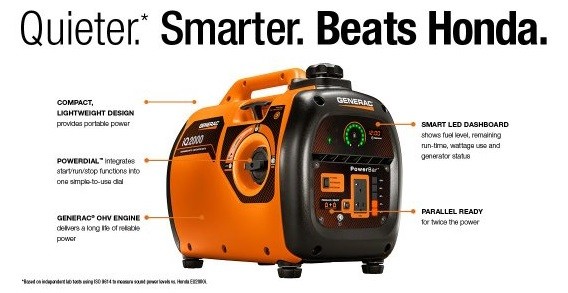
What is a generator?
Conventional generators have been around for quite some time, and the core principles used to make them have always been the same. They are made up of an energy source, which is usually a fossil fuel such as propane, diesel or gasoline. This energy source is used to power a motor that’s attached to an alternator to produce electricity.
The engine needs a constant speed of about 3000 rpm to produce a standard current that’s used by most households. If the engines speed fluctuates, the power output will also fluctuate.
Fuel type
Just about every generator runs off either gas, propane, or both. You’ll definitely want to choose a generator that you’ll have an easy time keeping fueled.
Gasoline generators
Gas generators are super efficient, easy for most people to use, and reliable. Gas motors aren’t complicated either so if your gas generator breaks, you will probably be able to figure out what’s wrong with it pretty quickly.
On the downside, gas can be hard to store without a fuel stabilizer. Also, if the power is out citywide, you can’t just go get some gas from a gas station. Gas pumps require electricity to work.
Finally, gas is a bit corrosive and can leave all kinds of residue behind. Gas generators will require regular cleaning. You’ll want to take good care of your carburetor, check your fuel lines, and look out for corroded gaskets.
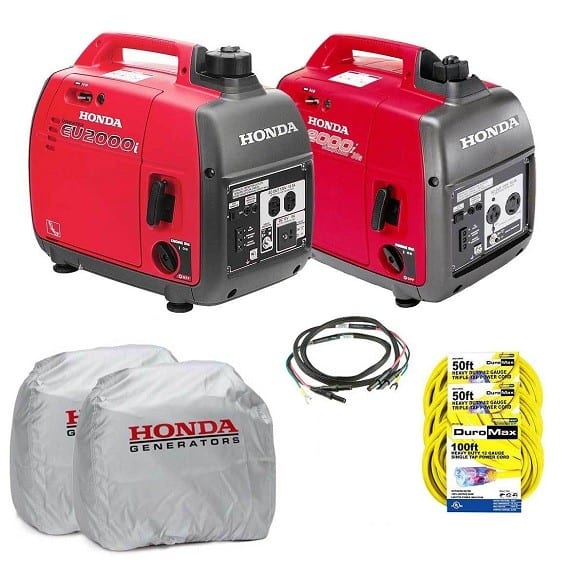
Propane generators
Propane is easy to store and has a very long shelf life. In addition, it is pretty much impossible to spill. Propane burns pretty clean as well meaning that you won’t have to clean your generator out as much.
However, propane is less efficient than gas. You’ll use more of it. Plus, propane engines can be complex and hard to fix. Finally, if you’re expecting cold temperatures, consider that propane is pretty much useless in temperatures below 20ºF.
Dual-fuel generators
Dual fuel generators are a great option as well. They let you use either fuel type, meaning that you’ll have a bit more room to improvise in a power loss situation.
Benefits of an Inverter Generator
The following are reasons why these generators are so popular.
Quality of Power Output
These generators produce power that is as reliable as line power. This is especially nice for powering your smaller devices like phone chargers, desk lamps and portable air conditioner units. Traditional generators, on the other hand, produce raw power that is best suited for powering large electrical systems like central air conditioning.
Portability
The inverter generator small is small and lightweight, making it easily portable. Despite its small size, the unit is very efficient. People bring it camping and in RVs. Traditional generators are bulky and a hassle to move. They have their uses of course, though you wouldn’t think to carry one along on a fishing trip.
Fuel Economy
This type of generator automatically adjusts the engine acceleration to produce only the needed power output. This makes for a smaller gas tank, lower fuel costs, and lower emissions. Traditional generators run at 3,600 rpm and at a frequency of 60 Hertz per cycle. The inverter generator runs at a lower rpm while maintaining the correct frequency for the load at hand.
Quiet Running
Because the engine never runs at full speed, they work quietly compared to traditional generators. The volume is supposed to be equal to human conversation. This makes taking a generator along on a trip more appealing because you can use it, literally, without the headache. For home use during a power outage, it won’t bother your neighbors.
Parallel Compatibility
An inverter generator can be coupled with another one when you need more power. You can use multiple generators to do the work of a larger, bulkier traditional generator.
Inverter generators vs generator – which one is better?
First, let’s not think of the traditional old inverters because they cannot power appliances which can be powered by generators. Here we’re going to talk about two devices that can generate electricity well. So which is the best between the two?
The difference depends on some factors, which includes the appliances to be powered, the number of appliances, and your budget. Let’s discuss some of the most important portable energy device factors and how each device stacks up for them.
Generator inverter size, weight, and portability
Many inverter generators are quite small for the amount of power they carry. Inverter generators are easy to store and transport, and for those who want some power for hiking or camping, inverter generators can easily fit in your car.
In contrast, many generators are usually noisy, heavy and bulky, which requires them to to be mounted on frame and wheels. While they are also portable, they lack the convenience factors of being smaller, quieter and lighter.
Inverter generator fuel efficiency and run time
Generators are mostly designed to generate a certain amount of power needed to keep electrical appliances running. With generators, factors like the size of the unit have not been mainly considered.
On the other hand, inverter generators are designed to be compact and lightweight since they don’t need big fuel tanks like generators.
Although a limited fuel capacity means they have shorter run times, inverters have fuel efficient engines which adjust the power produced to match the load’s requirements.
Inverter generators save up to 40% of the fuel and have run times of approximately 10 hours, which are just enough for most users. Inverter generators also help to reduce exhaust emissions.
Noise level difference between generator and inverter
According to GreenGear global, the main difference between inverter generator and a conventional generator is the noise levels. Generators are usually very noisy and run at constant speeds of typically 3600 rpm to produce electricity. The engine speed should remain constant to generate electricity.
On the other hand, inverters can adjust the amount of power produced using microprocessors. This means that the device can regulate its power output depending on the load applied making it quieter than generators.
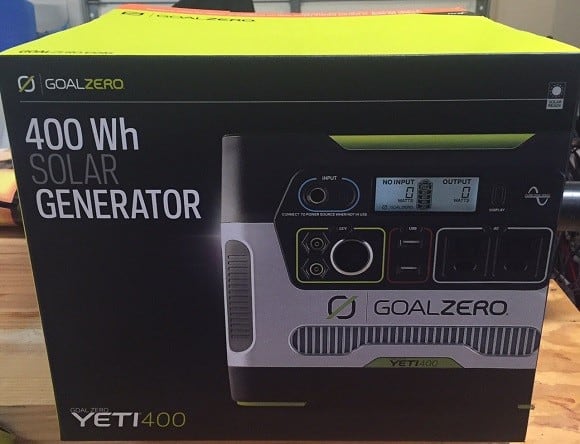
Quality of power generated by inverter generator
Since a generator is only an engine running at full speed to produce the desired frequency regardless of the load on it, the engine throttles up to keep the amount of generated electricity the same. The alternator’s output is directly connected to the load without processing.
With inverter generators, AC electricity is produced by converting direct current into alternating current.
DC capacitors smooth out the current produced to a certain degree before it gets converted into alternating current and the desired voltage and frequency.
Inverters produce consistent and reliable power which does not rely on the engine speed. The power generated by inverter generator is much “cleaner” than the power produced by conventional generators. This power is almost of the same quality as the electricity typically supplied by your electric company.
What’s the importance of using a cleaner power source?
Well, today most products including your televisions, mobile phones, and computers have microprocessors that are very sensitive to the quality of electricity used. If these devices use a power source that’s not clean, they may end up malfunctioning, or they might even get damaged.
Which is why I personally have, and truly trust, a solar generator. Any application that requires sensitive electricity (most devices do) will benefit from the cleaner power produced by inverters. I personally have and use a Goal Zero Yeti, but it has a finite amount of power stored…Goal Zero Yeti 400 Lithium
Inverter generator price comparison
There are fewer advantages when it comes to generators unless you need a very high power output. Conventional generators are also cheap and less costly to repair. Its simple design and functionality make the spare parts easily available at fair prices.
Although inverter generators are more compact, quieter, convenient and fuel efficient with controlled power outputs, they are available at higher prices.
But it’s up to you to evaluate how much you need each factor and how much you have budgeted for the device.
Review of one of the Best Selling Generators – WEN Inverter Generator
Parallel device operation inverter generator
Most inverter generators can be paired with identical units to double the powers capacity. With parallel capability, you can use smaller inverters to produce the same amount of power produced by one large generator.
Conventional generators do not have this feature. Conventional generators need special cables to connect them to their output, and they cannot be paired with identical units.
Read our review of the Champion Dual Fuel 9000 Watt Gas and Propane Generator.
Inverter generators vs conventional generator, which is the best?
It’s up to you to weigh the pros and cons of each of the devices for your situation. If all you need is some power where there isn’t any, and your more concerned about the budget the quality, a conventional generator will work for you. But most people have realized that convenience, quiet operation, clean power, and portability is exactly what they need.
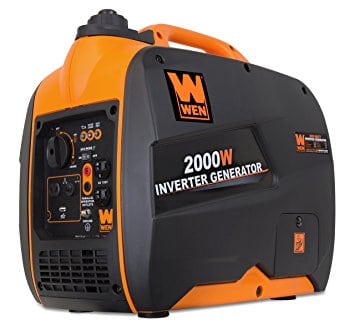
Generators with inverters offer better fuel efficiency
Inverters make generators significantly more efficient. These generators are able to automatically adjust their engine speeds to match the needs to the application that you are using them for.
They only produce enough power to run the electrical devices or appliances placing a load on them. This means that they will ultimately conserve fuel better.
Higher quality electrical parallel capability and output
Inverters automatically make a generator more technologically advanced. They produce power similar to the power that’s used in a home or residential area. Another feature is that you can also pair them with identical units for more power output.
So, instead of using a large and bulky standard generator that makes a lot of noise, you could use two inverter equipped generators and get the same power output with twice the efficiency.
Easier maintenance
Generators with inverters are easier to take care of than non-inverter variants. You won’t have to use as much fuel, meaning less residue, and longer continuous running time. You’ll have to inspect your battery once a year, but that’s about it.
With an inverter equipped generator, you’re not going to have to replace your carburetor, fuel lines, or gaskets as regularly. Plus, they use less oil.
How Much Gas Does a Generator Use?
Inverter generator – What you need to know
Inverter generators or standard generator: Which is best for you?
You can also checkout this Inverter Generator Reviews. We have also reviewed what we think are two of the best inverter generators on the market: Honda Inverter Generator vs Generac Inverter Generator
What are your options?
There are quite a few generators out there for you to choose from. You can decide between gasoline, propane, or combination dual-fuel generators.
- What fuel source will you have the easiest access to? Generators also come with various engine types and power output ratings.
- Are you only planning to power a few devices for the night or will you need a daily power source that you can trust for months at a time?
You can also choose between standard generators or inverter variants. Both have their uses and can be valuable assets when you need electricity on the fly.
Firman 2900 Watt Dual Fuel Inverter Generator
Whether you are a traveler who enjoys having electricity everywhere you go or a homeowner who wants to always be prepared, having a good inverter generator is a huge step forward. Consider choosing a Firman generator. Quiet, compact and portable, the Firman Dual Fuel Inverter Generator worked greatly for me.
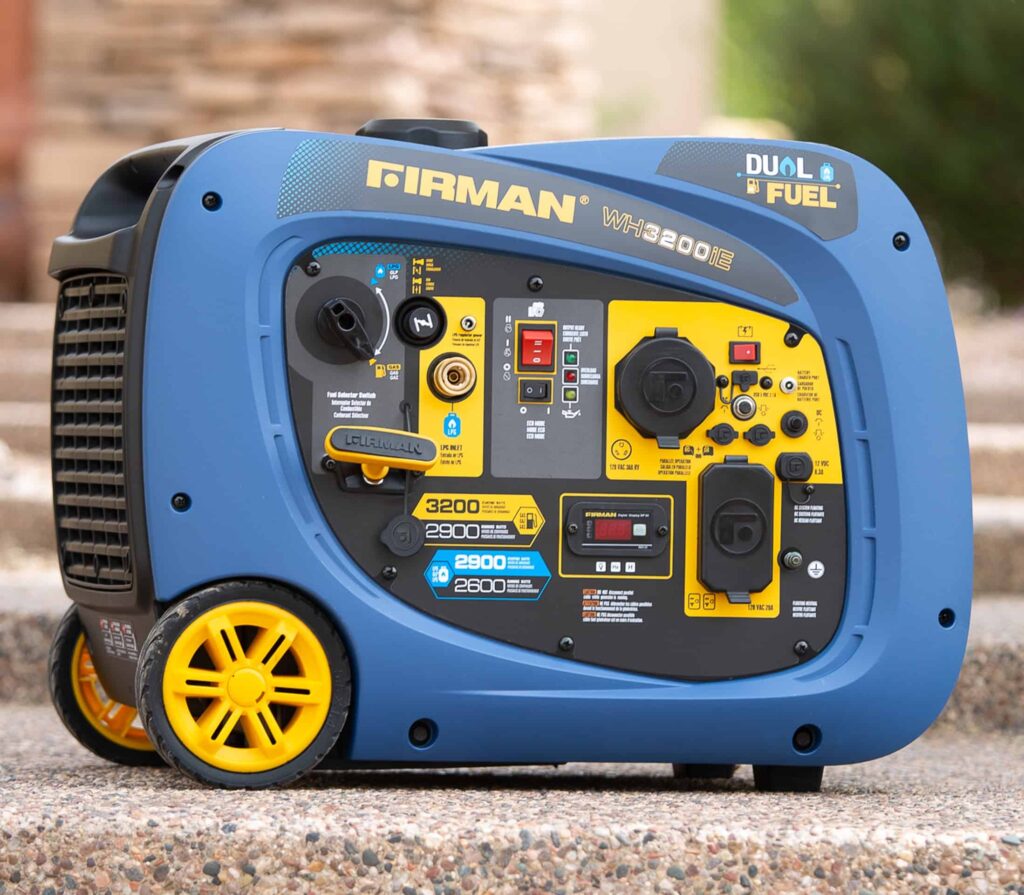
Without a doubt, in my case, the device’s practicality and convenience were huge selling points. However, what really convinced me that this is a great generator was its outstanding performance using either gas or liquid propane.
Firman Dual Fuel 3200 watt / 2,900 watt Inverter Generator
As far as I know, the Firman 2900 watt Dual Fuel Inverter Generator is the first inverter generator that can run on two different types of fuel. Take into account that, depending on whether you use gas or liquid propane, the device’s output may vary.
In fact, using gasoline allows a slightly larger running wattage of 2900W (and a peak wattage of 3200W). Meanwhile, using liquid propane gets you 2600 running watts.
Rest assured, however, as this difference is basically non-important for most uses. At any rate, having the choice between these two types of fuel makes the generator more versatile and practical.
Featuring a capacity of 1.8 gallons, the Firman Inverter Generator can run for up to 9 hours on a full tank of gasoline. Using propane instead of gasoline, that run time is reduced to 8.5 hours of continuous use.
For most people, that is certainly nothing to scoff at, particularly considering the consistency and reliability of the output.
As a matter of fact, this generator produces a clean sine wave with less than three percent of total harmonic disruption or THD. That means no sudden rises in wattage that could damage your electronic devices.
Design
In terms of design, there is a lot to say about the Firman Dual Fuel Inverter Generator. For one, it is notable that its closed body design provides security to all its components.
Without a doubt, this gives the device an advantage over traditional generators with an open frame. At the same time, the device is compact and lightweight enough so that one person can carry it.
With a total weight of 97 pounds, it can be easily lifted using its built-in handle. If that is not possible, though, don’t worry: The device includes a wheel kit that makes it even easier to move around.
In addition to all its main functions, the Firman Dual Fuel Generator boasts a few additional security and monitoring features that are certainly welcome.
Take the useful control panel for example. At all times, it shows important measurements such as voltage, frequency and remaining lifetime hours.
Whenever any of these measurements get too low, the device produces warning lights that will prompt absent-minded people like me to correct the situation.
In order to further ensure safety, the generator also features an automatic low-oil shut-off and a circuit breaker.
Firman Dual Fuel Inverter Generator Advantages
- It can be used with two different types of fuel.
- Compact and portable.
- Great performance.
But the Firman Inverter Generator, as with all dual fuel generators, will produces less wattage when used with liquid propane.
Personally, I like inverter generators – especially solar generators
They make generators run better and for longer. Plus, inverter equipped generators are generally a lot lighter, quieter, and more efficient. It’s easier to store them as well. However, if you need high-output power and don’t want to mess with anything overly complicated, standard generators work just fine.
If you’re going to go with a standard generator, I’d opt for a powerful and reliable dual-fuel unit.
No matter which generator configuration you ultimately choose, remember to consider your surrounding circumstances. Know where you’ll be using it, how much power you’re going to need, and if you will be able to maintain and clean your generator while off-grid.
Thanks for reading, and good luck!

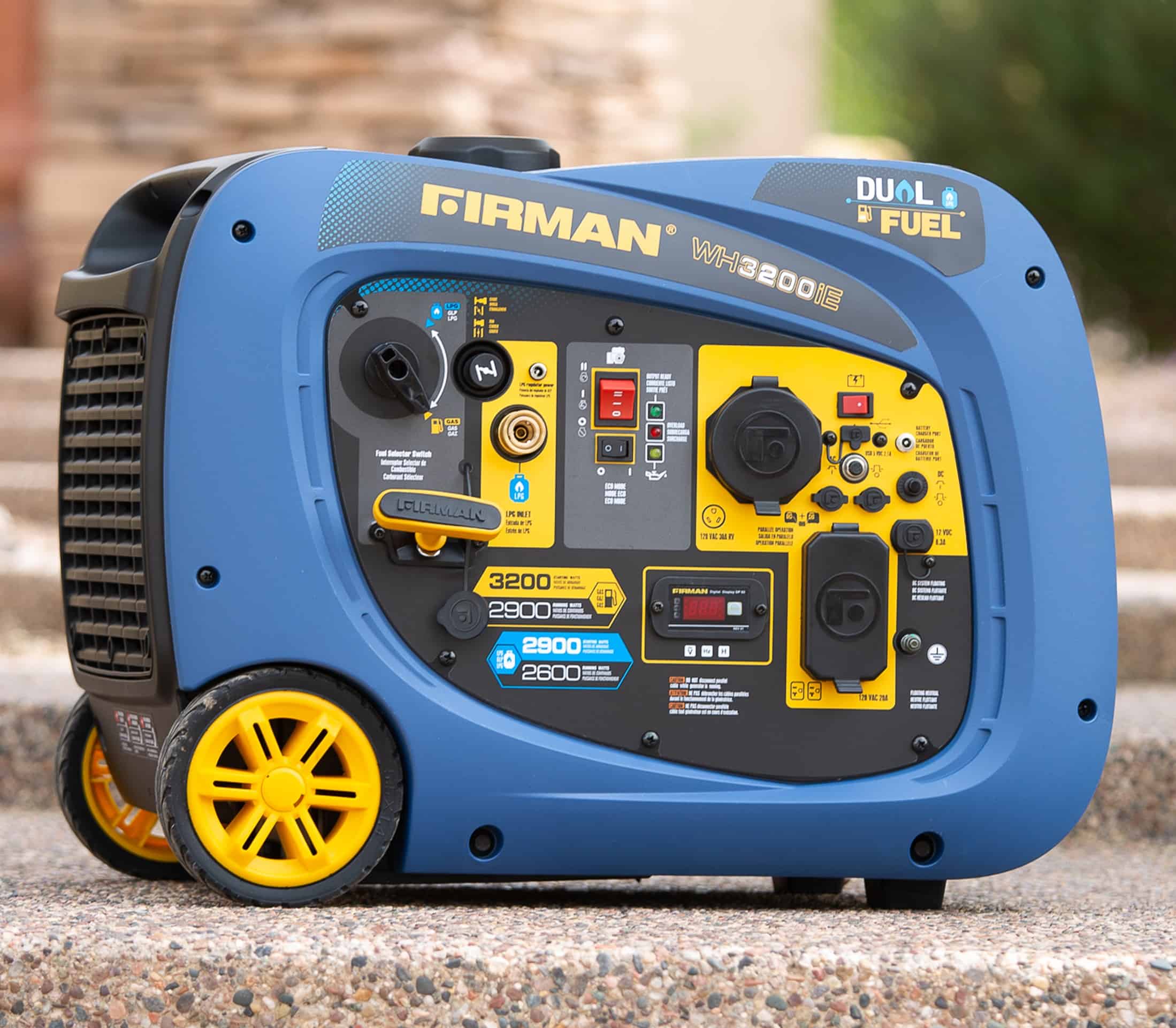
The conversion of power in an Invertor Generator from its engine-driven (variable Hz) AC to DC and then its electronic conversion from that DC to our typical load’s required 60Hz 120volt AC innately wastes energy due to the multiple steps, as compared with a pure generator’s simple creation of primary 60Hz 120volt AC by spinning its generator at 3600rpm. And the Invertor Generator must be slightly larger and heavier to be able to deliver the same output due to those extra steps. Simple physics. You cannot create something from nothing and no physical process is 100% efficient. An invertor generator is more efficient and quieter ONLY when the required load is often much less than its max capacity. If it is lighter and smaller it either has higher tech ($) or is unable to maintain max load as long or as safely. And making it prettier and handier costs too. So the advantages must be weighed against their extra cost. Choose the gen-type for the load-type. Again, nothing is free. Common sense.
In talking to a few heating contractors, they told me that today’s modern high-efficiency furnaces have circuit boards that will either burn out or not run, with a standard generator and you need an inverter generator to safely run them. This is also true for many electronic devices. I’m building a new house and leaving my old portable generator behind. I’ll be purchasing a large capacity inverter generator.
Am looking for small Inverntors/batteries that can light bulbs and light up a tv
There are several inaccuracies in this article. Any type of Inverter produces a “simulated” AC sine wave. That sine wave is created by microprocessor controlled oscillations of DC polarity to create, or construct, a simulated 60Hz, AC sine wave. The clock speed of the microprocessor controlling these oscillations determines the resolution or smoothness (quality) of the sine wave produced. Many oscillations are required to produce one sine wave. There is a sawtooth effect going on in the edges of a simulated sine wave. Inverters do a pretty good job of creating a sine wave, but they’re not perfect. Electronic equipment does not like the rough sawtooth effect which can exist in a low quality inverter. High quality inverters will produce a high quality (high resolution) simulated sine wave.
The clock speed of the microprocessor controlling the oscillations in the conversion process determines the resolution or degree of fineness in the sine wave. A low resolution simulated sine wave will have a more apparent sawtooth appearance on an oscilloscope. It will not be as smooth and pure. Conventional generators produce a pure sine wave which is electrically cleaner, and electrically noise free power. There is no conversion process needed. It’s pure AC power from the very beginning. The frequency of the AC power from a conventional generator is dependent on the speed of the engine driving the generator. That’s why they need to run at a fixed RPM. With inverters the frequency is processor controlled.
The “source” of the DC power in an inverter can come from batteries OR an engine powered DC generator. When the source is from batteries only, it’s usually just referred to as an inverter. When the source is an engine powered DC generator, the result is called an “inverter generator”.
And one other thing, unlike as was mentioned in this article, conventional generators can be electrically tied together to run in tandem or triple or even more. I’ve done this myself. Battle ship electrical systems were designed to be able to do this too. They had redundant capabilities which could be utilized in war. The issue in doing this is synchronizing the generator you’re bringing in with the others that are already running tied together. When synchronizing, battle ships used voltage meters connected across the legs of the phases, which measured potential between the generator being brought in versus the ones already running. In their case it was three phase power, but it can be done with single phase power too as is used in most homes. Before synchronizing, the one coming in would not be running at the exact synchronous speed as the others. It would be close, but not exact. There would be a slow, rise, fall, rise, fall seen on the volt meter as the two potentials resonated. All you have to do is close the switch to connect the incoming gen, when the volt meter falls low. When you do that you can actually see the two generators lock up electromagneticly. They will slightly jerk, just once, as they become synchronized. You can actually substitute the volt meter with incandescent light bulbs if you want to. The bulb will go bright, dim, bright, dim over and over. When it goes dim you can close the switch with a minimal spark. Don’t close it when it’s bright because the polarities are wrong in the sine waves when the bulbs are bright. After you close the switch with the bulbs dim, the generators will be synced, locked magnetically, and ready to work with increased capacity after you close the switch. This works. I’ve done it.
Question: I have two submersible well pumps (1/2hp) each and two pumps less than (1/2hp each). Will running a standard generator or inverter generator shorten/endanger the life of the pumps? Thank you in advance.
I have the same question as Gene
I need something that’s about three thousand Watts lightweight quiet and dual-fuel
These are the ones I recommend:
Champion 3400-Watt Dual Fuel RV Ready Portable Inverter Generator with Electric Start
Westinghouse iGen4500DF Dual Fuel Inverter Generator – 3700 Rated Watts Gas & Propane Powered – Electric Start
Champion Power Equipment 100402 2000-Watt Dual Fuel Parallel Ready Inverter Portable Generator
This one looks promising Firman 2900 Watt Inverter Generator , but I do not have any experience with this. If you buy this one, let me know what you think
You are linking directly to amazon for free when you could get paid for it using referral links. look into it!
To have a backup for an oxygen machine i would have to also buy a battery for a inverter generator. Is this a good idea or would a small generator be best bet. The above is for my residence, not a vehicle.
I have some medical devices as well that I have back up power for that I’m very cautious to have ‘clean’ electricity…sine wave or modified sine wave. I have both, a ‘Solar’ backup generator (Goal Zero Yeti 1400 Lithium Solar Generator and a Goal Zero Yeti 400 Lithium Solar Generator) and an Inverter generator (Firman Inverter Generator). I would not buy the Yeti 1400 again (or if I could go back in time), it just to big move around and handle. The Yeti 400 with the Firman Dual Fuel Inverter Generator is an excellent setup for both short term power outages, traveling and long term power outage. I can use my device directly plugged into any of them, and I can re-charge my Yeti’s with the generator as well if needed. I also have the adapters so I can charge the Yetis in my car as well.
I take the Yeti 400 camping all the time. Usually last 2-3 days/nights before I need to re-charge it via a portable solar panel, my car or just plug it in somewhere I can. Haven’t taken the Firman camping or traveling yet but I will next trip.
Few other article you might want to review as well:
https://rurallivingtoday.com/generators/power-inverters-vs-generators-which-best/
https://rurallivingtoday.com/generators/best-backup-power-outages/
https://rurallivingtoday.com/generators/best-solar-backup-generator-goal-zero-diy/
https://rurallivingtoday.com/generators/top-best-portable-generators-can-buy/
https://rurallivingtoday.com/generators/honda-inverter-generator-vs-generac-inverter-generator/ (I think Honda makes a great product but I think I get more value from others…cost/benefit has shrunk dramatically in recent years)
https://rurallivingtoday.com/generators/top-best-portable-generators-hurricanes-portable-generator-reviews/
https://rurallivingtoday.com/generators/wen-inverter-generator-review/
https://rurallivingtoday.com/generators/honda-eu1000i/
https://rurallivingtoday.com/generators/honda-eu2000i/
I started writing these articles based on my research due to my PERSONAL necessity of NEEDING electrical power in case of an outage and for traveling.
Great article Rural Living Today.
You guys know if you put two scientists or two engineers or more in a room together none of them agree 100% on anything esp the bright ones lol. The great thing about that is: (dumb people like me or lack of experience i should say. Ok we can go with dumb). Get a chance to learn from all of you lol
Anything in This World that is created by man should always be looked at from as many angles, sides, views or theories and all of the important things in those views considered when making a judgement call or executive decision.
It seems to me that an inverter generator would be great for uses that do not require two heavy of a power demand and where electronics need to be handled delicately. TV. Phones, computers ect ect…
And a conventional generators used in the more heavier duty situations. I use generators for my fifth wheel. And when that Air Conditioning kicks on your generator better be ready to handle the load, because those dual units up top don’t play! Roy and Ken. Your replies makes me think an inverter generator would be less reliable in a HD situation because there is more electronic processes going on and electronics are more app to fail than mechanical a lot of times. Because of moisture, humidity. Dirt and dust. (I’m just being technical here because that is just what we are doing right?) I’m not to privy on electrical matters either.
And Ken. Man, your story about the paralleling of generators on the open seas got my attention. Id like to spend some time with you and pick that brain! Very Cool brother. Old School is the New School.
Semper Fi
Chris R.
Shark Management Group LLC
I never knew that the device should use a clean power source so it won’t malfunction any electronics. My brother wants to install a backup generator for his house since he is worried about hurricane season. I’ll have to help him find an electrical service that can get it installed for him.
Check out the article https://rurallivingtoday.com/generators/kohler-generator-vs-generac-generator-right/
DO NOT BUY THE GENERAC 2000 iQ. Out of the 5 we bought from Costco, only 2 have worked and the screws were rattling out of the working two due to poor quality control. Generac is junk. Choose Honda, Yamaha or Champion.
So..what about getting a conventional generator AND a high quality inverter. Two separate units but on easily plugs into the other. Then plug your appliances and other sensitive stuff into the inverter. Can this work? Inquiring minds need to know.
Yes, that is the set up I used for years before I got an Inverter generator. But I highly recommend an inverter generator. It is way better and more efficient
This review has helped me a lot in finding a good generator I was having electricity issues and I didn’t knew which generator is good and what to buy. This will be a great start for the new year 2021. Thanks for the review.
And one other thing, unlike as was mentioned in this article, conventional generators can be electrically tied together to run in tandem or triple or even more. I’ve done this myself. Battle ship electrical systems were designed to be able to do this too. They had redundant capabilities which could be utilized in war. The issue in doing this is synchronizing the generator you’re bringing in with the others that are already running tied together. When synchronizing, voltage meters connected across the legs of the phases, which measured potential between the generator being brought in versus the ones already running. In their case it was three phase power, but it can be done with single phase power too as is used in most homes. Before synchronizing, the one coming in would not be running at the exact synchronous speed as the others. It would be close, but not exact. There would be a slow, rise, fall, rise, fall seen on the voltmeter as the two potentials resonated. All you have to do is close the switch to connect the incoming gen, when the voltmeter falls low. When you do that you can actually see the two generators lock up electromagnetically. They will slightly jerk, just once, as they become synchronized. You can actually substitute the voltmeter with incandescent light bulbs if you want to. The bulb will go bright, dim, bright, dim over and over. When it goes dim you can close the switch with a minimal spark. Don’t close it when it’s bright because the polarities are wrong in the sine waves when the bulbs are bright. After you close the switch with the bulbs dim, the generators will be synced, locked magnetically, and ready to work with increased capacity after you close the switch.
This is interesting- does this assume both generators are very closely matched in frequency and voltage output? How does those parallel operation kits work where the two independent generators are designed for this?
Better off with solar and battery option and if extra power needed conventional generator
Have a nice day
I have a generlink to hook generator to power the house in times of outages works great and no problems with powering sensitive electronics. It’s 10,000 watt BE runs at 7400 full constant load. An electrician is needed though to install the generlink between meter and service which acts as a surge protector also. Simple 1 cable hookup so I keep the generator in the garage until needed as it has wheels for easy moving to meter. Easily powers entire house. Great backup when needed.
How much does it cost to have a 2.0kva inverter generator?
These types of inverter generators can usually run between $600 to about $900 on average.